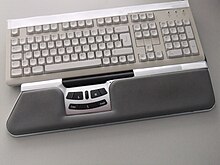Roller bar mouse
The roller bar mouse is an ergonomic further development of the conventional computer mouse . It is also known as "roller bar" or "bar mouse", "roller bar" or "roller mouse" and differs from the trackball .
In the course of the increasing occurrence of usage-related complaints ( RSI syndrome ) through frequent, stereotypical movements (in English: repetitive strain) when using the computer mouse and keyboard, the need for alternative operating options arose. Operating overload should be avoided or at least reduced by changing the positioning and mechanics.
The first roller-pole mice appeared in the USA in the 1990s. They are widespread in Scandinavia, and over a million devices are in use worldwide.
functionality
The roller bar is located directly in front of the keyboard, embedded in a flat palm rest. It lies in the middle and can therefore be conveniently operated with both the right and left hand. Moving the cursor on the screen is done by rotating or sliding the bar sideways. The click and double-click function takes place via integrated special keys, the assignment of which can be optionally adjusted. These special keys can be operated with any of the 10 fingers.
Areas of application
Today's roller bar mice with their individually assignable special keys can be used without restriction instead of a conventional computer mouse. This applies both to common office applications and to CAD programs for mechanical engineering. The motor changeover from mouse to roller bar mouse is uncomplicated. New users adapt immediately to the new cursor guidance, even with a minimal introduction. If necessary, both pointing devices can also be used in parallel. The user then has the choice of changing at any time or using the conventional mouse for certain activities.
In 2008, computer users were asked about their experiences with alternative pointing devices in a non-representative online survey. Of the users who suffered from severe discomfort with the conventional computer mouse, 14% had chosen a roller-bar mouse.
Working with a roller bar mouse is often perceived subjectively as more pleasant. After a two-week test phase, test participants reported a significantly reduced pain level in 2002.
Muscular comparative studies
A Swedish-American study from 2008 recommends the use of a roller-bar mouse in the case of corresponding muscular complaints. The researchers took electromyographic measurements on two groups of test subjects . Those participants who did not use a conventional mouse but a roller-pole mouse showed significantly lower muscle tension. Studies from 2012 and 2013 came to similar results.
Web links
- Redesign of an Ergonomic Computer Mouse (Swedish design students' thesis from 2011)
- Muscle activity in the mouse, touchpad, trackball and roller bar mouse (English-language conference presentation from 2013)
Individual evidence
- ↑ Current overview of accessibility features for the disabled , loaded July 7, 2014 (English)
- ↑ Self-testimony of a US manufacturer , loaded July 7, 2014
- ↑ Magazin Arbeitsicherheit Schweiz : an alternative to the conventional mouse ( memento of the original from July 14, 2014 in the Internet Archive ) Info: The archive link was inserted automatically and has not yet been checked. Please check the original and archive link according to the instructions and then remove this notice. , September 2011 edition, p. 20, loaded July 8, 2014 (PDF)
- ↑ Brack, Alina in Swiss IT Magazine : Roller mouse for healthy posture January 2014 issue, loaded July 7, 2014
- ↑ closer to the keyboard and thus 4.7% faster to reach: [1] , loaded July 10, 2014
- ^ English-language review in the US trade journal PC Magazine from April 26, 2012, loaded July 7, 2014
- ↑ Tara, Roopinder: Contour RollerMouse or Carpal Tunnel Syndrome? , (English experience report) dated December 14, 2013, loaded July 8, 2014
- ↑ Wichita State University's US study : Examining First-Time Usage of the RollerMouse , August 12, 2003, loaded July 8, 2014
- ^ Röbke-Doerr: When mice hurt ( Memento from March 12, 2010 in the Internet Archive ), C't magazin, April 2008 issue, loaded July 9, 2014
- ↑ Golden, James: A controlled study of responses to a centrally controlled bar mouse compared to a standard ambidextrous 2 button mouse. , (Study at Rutgers University from 2002, here a summary), loaded July 10, 2014
- ↑ Kumar, Rupesh and Kumar, Shrawan: A Comparison of Muscular Activity Involved in the Use of Two Different Types of Computer Mouse loaded July 7, 2014
- ↑ Penzkofer, Mario: Roller bar system vs. conventional computer mouse - electromyographic and subjective assessment of stress for mouse pointer control , symposium of the Institute for Occupational Medicine, Safety Technology and Ergonomics eV , Bergische Universität Wuppertal in November 2012, page 31, loaded July 8, 2014
- ↑ US study, still in a peer review , presented in advance on March 19, 2013 at the Applied Ergonomics Conference: Evaluating the Effect of Four Different Pointing Device Designs on Upper Extremity Posture and Muscle Activity during Mousing Tasks ( Memento of the original from 14. July 2014 in the Internet Archive ) Info: The archive link was inserted automatically and not yet checked. Please check the original and archive link according to the instructions and then remove this notice. , loaded July 8, 2014
